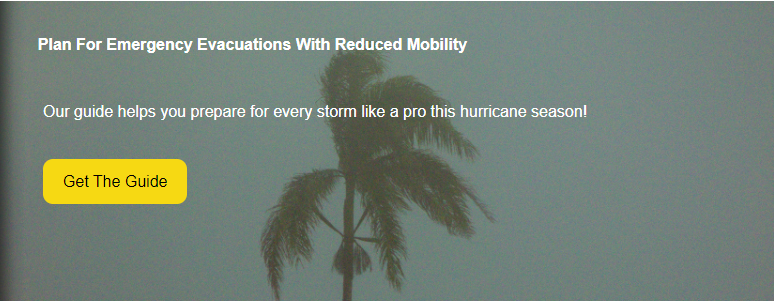One minute you’re waiting for the kettle to boil, the next you’re struggling to hear your voice over the siren heralding the arrival of an inopportune hurricane. And though just 1 out of 10 warnings constitutes a serious threat, a helper of someone with mobility impairment needs to be prepared for the worst in order to safely execute their hurricane evacuation plan.
However, before you can put your action plan into effect, you need to remain calm and think clearly in the face of a warning or serious storm. We’ve got some effective tips to help you do that:
Remain positive in the face of emergency
Because the person you’re helping will be looking to you for guidance, it’s vital you put on a brave face and neutralise any panic with smiles, support and positivity. Affirm yourself and your capabilities in your own mind with motivating mantras like ‘relax’, stay calm’, or ‘keep moving forward’. By doing so, you set yourself at ease and radiate composure and leadership to the person you’re assisting.
Pay attention to your breathing
During an emergency, your heart rate spikes and your breathing becomes more shallow and rapid. By keeping your breathing under control, you actually bolster your ability to remain calm and decisive in the face of disaster. Here are some tips to avoid the dreaded ailment of hyperventilation with diaphragmatic breathing:
- Inhale long and slowly into your lower lungs, followed by your upper lungs.
- Hold your breath and count to ‘three’.
- Breathe out slowly through pursed lips, while relaxing your face, jaw, shoulder, and stomach muscles.
- Repeat.
Have a hurricane evacuation plan ready to go
Part of remaining calm is being prepared. When you’ve got an evacuation plan set in stone, you alleviate much of the worry and confusion that comes with a natural disaster. Start by getting hold of the building plans, which will detail the primary and secondary evacuation routes, as well as stairwells in your close vicinity. Have the person you’re helping on speed dial (and vice versa) so that you’re able to make contact easily and meet up as quickly as possible. Ensure that both parties know every step of the plan, where to meet and where to go.
Build up a hurricane kit over time
Tackling evacuation with a person who has mobility impairment requires no small measure of careful planning. A worthy addition to your evacuation arsenal is a hurricane or storm kit. With this kit in an easy-to-reach place, you’ll be able to weather the storm with confidence. The following are just a few of the necessities your kit should include:
- A waterproof storage container for your items.
- 1 gallon of water per person, per day, with enough to cater for pets too. Keep a 3-day supply for evacuation, and 2-weeks for home.
- Non-perishable, easy-to-prepare food items for you and your pets. Plan for a 3-day supply for evacuation, and 2-weeks for home.
- A medication and first aid kit with enough supplies for 7 days.
- Emergency cellphone with charger, as well as a flashlight and spare batteries.
This is just a taste of what your storm kit should include. For the full rundown, read our new brochure ‘Hurricane Preparedness For The Mobility Impaired’.
Invest in a mobility aid
A mobility aid is not just for a disabled person’s peace of mind, but yours too. It completes a solid hurricane evacuation plan and ensures that stairs won’t present a problem when disaster strikes.
Mobile Stairlift is an easy-to-deploy stair chair that helps a person with mobility impairment quickly and safely descend stairs with the assistance of their carer. You activate the footbrake and they get in and strap up when it’s time to evacuate. This battery-operated stair chair can carry up to 500 pounds for as many as 120 flights of stairs on a single charge, so you’ll never be stranded when disaster strikes.
For more information on how Mobile Stairlift assists with a hurricane evacuation plan, click here. Don’t forget to check out our handy checklist and emergency to-do list! If you have any further questions, don’t hesitate to get in touch.



